On Jan. 21, 2020, the U.S. reported its first case of the coronavirus in the state of Washington — a man in his 30s became infected. In the past 15 months, the world has gained an immense amount of knowledge about the coronavirus. Let’s take a look at the major developments since then.
Jan. 30, 2020: The World Health Organization declared the coronavirus outbreak a global public health emergency.
Feb. 11, 2020: The WHO announced that the disease caused by the novel coronavirus would be called COVID-19.
Feb. 29, 2020: The U.S. reported its first death from the coronavirus — a man in his 50s in the state of Washington.
March 11, 2020: The WHO declared that the coronavirus outbreak can be characterized as a pandemic, which is defined as the worldwide spread of a new disease for which most people do not have immunity.
March 16, 2020: U.S. researchers administered “the first shot to the first person in a test of an experimental coronavirus vaccine.”
March 24, 2020: The WHO warned that the U.S. could become the global epicenter of the coronavirus pandemic, two days before total recorded deaths in the U.S. passed 1,000 and three days before recorded coronavirus cases in the U.S. surpassed 100,000.
March 30, 2020: Arizona Gov. Doug Ducey ordered a stay-at-home directive for the nearly 7.3 million residents of his state.
April 13, 2020: The U.S. Food and Drug Administration cleared the first saliva test to diagnose COVID-19.
RELATED: CDC and FDA issue joint pause on Johnson & Johnson coronavirus vaccine
April 23, 2020: The number of recorded coronavirus deaths in the U.S. topped 50,000.
July 5, 2020: The number of coronavirus cases in the U.S. surpassed 3 million.
July 20, 2020: The number of coronavirus cases in the U.S. surpassed 4 million.
Aug. 4, 2020: The number of coronavirus cases in the U.S. surpassed 5 million.
Oct. 1, 2020: Former President Donald Trump announced that he tested positive for COVID-19.
Dec. 11, 2020: The FDA authorized Pfizer’s coronavirus vaccine for emergency use.
Dec. 14, 2020: Vaccine rollout began across the U.S.
Dec. 15, 2020: The FDA authorized the first at-home, over-the-counter test for COVID-19.
RELATED: Coronavirus resurgence leads to declining mental health among health professionals
Dec. 18, 2020: The FDA authorized the Moderna coronavirus vaccine.
Jan. 6, 2021: The Centers for Disease Control and Prevention announced that it had found at least 52 confirmed cases of the B.1.1.7 variant in California, Florida, Colorado, Georgia and New York; and it also stressed that there could already be more cases in the country.
Jan. 25, 2021: The U.S. reported its first case of the Brazil coronavirus variant in Minnesota.
March 8, 2021: The CDC released new guidance for Americans who are fully vaccinated, meaning they are two weeks out from their last vaccine dose.
March 24, 2021: Arizona opened its vaccine eligibility to residents who are 16 years of age and older.
March 29, 2021: The CDC released a new study saying that the two mRNA vaccines, made by Pfizer and Moderna, are highly effective at reducing the asymptomatic spread of the coronavirus.
March 31, 2021: Pfizer reported that its coronavirus vaccine is extremely effective in adolescents ages 12-15 years old.
April 13, 2021: The CDC and FDA issue a joint pause on the administration of the Johnson & Johnson vaccine due to concerns of a rare type of blood clot.
April 16, 2021: The U.S. reached the milestone of 200 million vaccines administered.
Follow Amit Syal on Twitter









